#this is not a mister miracle story kirby would have written
Text

February 2006. The best of the interlocking miniseries making up Grant Morrison's 2005–2006 SEVEN SOLDIERS OF VICTORY event is SEVEN SOLDIERS: MISTER MIRACLE, one of the very, very few non-Kirby Mister Miracle iterations that's worth bothering with. Scott Free's former protégé Shilo Norman, introduced late in the Kirby MISTER MIRACLE series, is now a 23-year-old international superstar escape artist — and also the champion of the fallen New Gods, the possessor of the last Mother Box, and the only living creature immune to the Anti-Life Equation. Here, Metron and the Black Racer, incarnated in human bodies, play chess for Shilo's life, as Shilo is attacked by living cars, "the crazy horses of sunless Armagetto," in the "drive-by derby."
#comics#seven soldiers#seven soldiers of victory#grant morrison#billy patton#freddie williams ii#michael bair#mister miracle#fourth world#shilo norman#metron#the black racer#this is not a mister miracle story kirby would have written#but it understands what the kirby series was about#(and that it was ABOUT something at all)#and it modernizes the concept in ways that make sense#thematically as well as just in style and topicality
7 notes
·
View notes
Text
Time for more Fourth World posting that no one asked for! I've previously written about the Fourth World comics of the 1970s and the 1980s, so here are the 1990s:
New Gods (1995): I FOUND IT! I FOUND A GOOD NEW GODS COMIC THAT ISN'T BY JACK KIRBY!!!
Okay, so the art is 1995 in the worst way, but the first 11 issues (written by Rachel Pollack) are actually excellent? The problem with previous New Gods runs was that it's hard to write about a utopian world at any length, but writers tried to introduce conflict by having the people of New Genesis be shitty, which undercuts the whole...utopia thing. Pollack has the corruption come from outside, which makes all the difference.
Basically, Darkseid manages to invade the Source (God, essentially, but more of a place than an entity) in an attempt to conquer it, but Orion follows him, and, desperate to stop him, kills him. However, committing patricide within the heart of the Source corrupts it, causing natural disasters on Earth and making everyone on New Genesis go evil or crazy or both. Which was all part of Darkseid's plan (he regenerates himself out of Orion's flesh, which is both very gross and a total mic drop moment) but now the cosmos are in upheaval and that's bad for everyone.
The other thing this book does that most post-Kirby New Gods books don't manage to do is treat Orion like an actual goddamn hero. Yes, he is angry and violent and makes bad decisions driven by destructive impulses. But he also loves Highfather and Lightray and New Genesis deeply, and this book allows those things to be stronger in him than his rage, and I'm crying about it. HE IS ACTUALLY A GOOD PERSON HE'S JUST ALSO A VERY CRANKY ONE.
The last few issues are by John Byrne and the plot and tone diverge pretty sharply but that's a lead-in to a different series so I'll talk about that in a bit.
Mister Miracle (1996): The universe tends towards balance and so because New Gods (1995) was good, this comic sucks. It sort of fits into the same continuity (it takes place after Darkseid dies), and so everyone on New Genesis is kind of being an asshole. But a lot of it just doesn't make sense and isn't explained? Like, they want Scott to be the new Highfather, even though Highfather is totally around in the concurrent New Gods series, and also this is presented as just a thing that everyone knew would inevitably happen, which...no? Honestly, the things that happen in this comic are so bizarre and arbitrary - characters appearing out of nowhere, continuity errors, random and baffling changes to the lore - that I kept thinking they were going to reveal it was all a dream. Bad.
Jack Kirby's Fourth World: So in the last 4 issues of New Gods (1995), Bryne takes over and long story short, Apokalips and New Genesis are smooshed together into one planet split down the middle (and also Orion dies). This series picks up from there and also ties into the Genesis miniseries. Byrne's art is always great, but the stakes are so exhaustingly high (the planets are smooshed together! now they're separated! Orion's dead! now he's back! now Highfather's dead!) that I started feeling numb pretty quickly.
It also relies heavily on the whole "god" thing, which means way more religious themes than I'm particularly comfortable with. (And yes, Kirby also drew very heavily one biblical themes but more for worldbuilding. He didn't have everyone on Earth "lose faith" because of issues with Source, as if atheists are just fooling themselves.) I just don't need that much Thor and Odin in my Fourth World comics, and the two of them repeatedly saying that they are "the closest to the Old Gods" is way too literal. (A commonly accepted version of events is that one of Kirby's biggest frustrations with Marvel was not being able to write a Ragnarok story and kill off Thor and his supporting cast, which is why he came to DC...where he immediately opened his book about NEW gods with the words "There came a time when the old gods died!" and a clear depiction of Ragnarok. This fan theory has several holes in it, not least of which is that Kirby did draw a Ragnarok story for Marvel, but the aggressively obvious allusion here just feels like Byrne is elbowing me in the ribs going "Get it? GET IT?")
Also, there are weird changes to the lore. I've mentioned before that in Mister Miracle #1, Scott is clearly already familiar with Earth, meaning some time has passed between his escape from Apokalips and our first sight of him...but Kirby has him living on Earth for two hundred years before Mister Miracle #1, including marrying a woman who isn't Barda - as if the idea that Scott and Barda had spent that long apart or that it took Barda that long to decide to leave Apokalips makes any sense at all. Tigra, Orion's mom, spends issues and issues claiming Orion is the result of a one night stand she had with some guy and thus not Darkseid's kid, and nobody really believes her but it's never actually resolved. Also, Infinity Man turns out to be Darkseid's brother??? What the hell.
This series also has a lot of Takion, a real Original Character Do Not Steal of a guy if ever there was one. He's Paul Kupperberg's OC, not Byrne's, but he shows up and is sparkly and more powerful than everyone and can talk to the Source and all the other characters ask him for advice all the time even though he literally just showed up and Beautiful Dreamer is in love with him and then he becomes the new Highfather. Big Mary Sue energy. Also he looks like a ripoff of Waverider, who is already firmly in Original Character Do Not Steal territory.
Anyway the series ends with Apokalips and New Genesis gearing up for a final, major clash...and then the last issue is literally just Byrne retelling a mashup of Forever People #1 and Superman's Pal Jimmy Olsen #147, but setting them in the post-Crisis universe instead of their original pre-Crisis framework. And then it's over. What? What???
Anyway on to the 2000s and the series I've been looking forward to since I started this project, Walt Simonson's Orion! See you in the next post!
14 notes
·
View notes
Text
IT’S ONLY FOREVER: THE ETERNALS RECAP PART 1
ALONE IN THE UNIVERSE: THE ETERNALS ISSUE 1
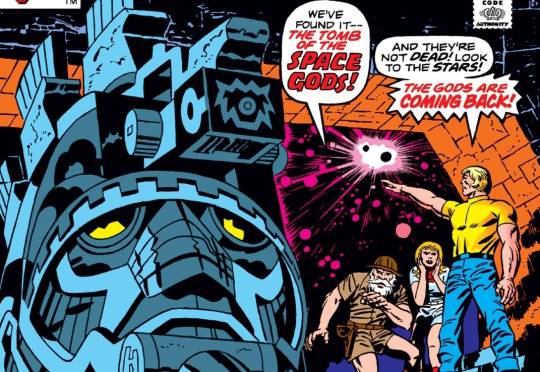
Jack Kirby is the king of comics for many reasons, like his peerless art, boundless creativity, and frightening productivity. Also probably his amazing narration skills. Check out Mister Miracle to see what I really mean. But you can also check out The Eternals, which opens with the most powerful question of all:
“IS MAN ALONE IN THE UNIVERSE?”
If you’re a thoughtful Marvel comics reader, though, you might recognize a flaw in this question. The year was 1976, and it had been 14 years since Jack Kirby conclusively answered that question in Fantastic 4 Volume 1 Issue 2, “The Skrulls From Outer Space.” Mankind is not alone in the Marvel Universe, because there are Skrulls and Galactus and Impy the Impossible Man. Likewise, Jack Kirby had also already told us mankind is not alone on the Earth, because he has written comics featuring Atlanteans (like Attuma) and mutants (like Unus the Untouchable) and Inhumans (like Aireo).
So what’s the deal? Well....
Literally in this first line, I realized something no one has ever said about the Eternals before: this book is not supposed to take place in the Marvel Universe.
Mankind is not alone in the universe, but the Eternals are alone in their own Universe.
This thought is something we’ll be tracking throughout our read-through. I’ll tell you now, there’s more evidence coming soon, notably that Not A Single Other Marvel Character Even Cameos In This Book.

Depicted: The kind of thing the Fantastic 4 usually would handle
Look, it makes sense. Kirby did not like having his characters messed with. We know he resented the way his ideas got treated once he was gone, and we know he desperately wanted to make his Own Thing. That was the point of New Gods, right? Kirby wanted to carve out his own part of the DC Multiverse; he wanted to tell one complete story that no one else could meddle in. And he tried, but then they did.
So it obviously makes sense that Kirby would want to just have his own little sandbox to get cosmic in, without needing Reed Richards to explain why the Celestials can’t just be threatened with the Ultimate Nullifier this time.
But it explains, already, one narration box in, why this comic feels like such a weird fit in the Marvel Universe. It isn’t about Skrulls or Kree or Kronans. You’ll see that it doesn’t really mesh with Marvel’s everyman themes. This is something new.
This is...well, it’s...something.
There’s probably more worldbuilding in this issue than in any other single issue of any comic, but the plot that happens is basically just a lot of people going to South America. Which is fine, I guess. We’ll talk about the plot later, but let’s take this time to establish some of the primary lore elements we’ve learned so far.
Eons ago, unknowable space gods called the Celestials came to Earth. They saw apes, and like any unreasonably powerful godlike beings, they decided to evolve them into three forms.

Depicted: Some Deviant art
Humans are pretty run-of-the-mill. The Jolteons of the crew, if you will. You know them: they love to cause problems on purpose and on accident. The second bunch are the Deviants. They aren’t artists who love Sonic the Hedgehog, but horrific monstrosities who love doing evil. Flareon, of course. And lastly, the Vaporeons: the Eternals. The Space Gods’ greatest triumph. We learn in this issue that the Eternals are beautiful, cannot die, can hover, shoot lasers out of their eyes, and probably do whatever. Then the Celestials left, only to return semi-regularly to check in on their cool evolutions. Throughout history, Eternals and Deviants have appeared in human legends as gods, heroes, monsters, and demons. And now, in 1976, we are finally becoming aware of this fact as the Celestials return to cast their final judgment on all three species.
They’re doing this in some incredibly-cool-looking Kirby space ruins, located in an Inca temple. Cultural appropriation is obviously a big problem in all Ancient Alien comics, but I can’t deny that the visuals are the best part of the Eternals.

Depicted: South America is basically space
We meet a few characters as well, who are going to show up a few times. The Professor and his daughter Margo are our two main humans. He’s studying ancient history, and has agreed to let a mysterious man named Ike Harris show him these ancient ruins.
Who is Ike Harris? Well, if you say that name really quickly, and pronounce the “I” incorrectly, you’ll realize he’s Ikaris the Eternal, in disguise to try to get to the Andes to send a beacon to guide the space gods back to Earth. We don’t know much about Ikaris yet, aside from that he’s a handsome blond man who can shoot lasers out of his eyes and rearrange the atoms in the air to turn it into a solid wall.
Also joining the fray in this issue are Kro and Tode of the Deviants. Kro looks like how the devil looks when he shows up in certain Twilight Zone episodes, except he has the sunglasses that the Koopa Troopas wear in the early Paper Mario games, and Tode looks like Jabba the Hutt with arms and legs. The Deviants have a couple of key problems. One is that they can’t produce consistently-viable offspring and are instead breeding Deviants who are basically just Humans. The other is that they don’t want the Celestials to return to Earth, presumably because they’ve been naughty and they’ll get in big trouble.

Depicted: Kro’s parents
Also they live at the bottom of the ocean and shoot down airplanes for no real reason.
So the last thing you need to know is that Kro and his henchmen ride a submarine through a stone dragon’s mouth to reach these Inca ruins from underwater, which is a little weird when you remember that most Incan structures are several hundred miles above seawater.
And then, here we are: Humans! Deviants! And Eternals! Together in an Incan ruin, with the Celestials on their way.
It’s a dense issue. We literally learn all of these facts here, and still have time for Kro to try shooting Ikaris with a laser gun. I have no idea how quickly they’re gonna attempt to explain all of this in a major motion picture, but we’ll worry about that later on I guess. For now, we’re left off an exciting cliffhanger: the Celestials are on their way back to Earth, and no one knows if that’s good or bad!!
We aren’t alone in the Universe, but I’m kinda thinking things were an awful lot simpler when we were.

And coming next issue...Does Jack Kirby know any Inca mythology anyway?
12 notes
·
View notes
Text
Comic Review – Mister Miracle

Darkseid has often been presented as THE big bad for large DC Comics events. Much like how the Marvel Movies used Thanos (Thanos is basically a mashup of Darkseid and Metron). He is the existential threat, the final boss and because it's comic books he is an evil rock monster in space that Superman can punch. Darkseid can fill that role fine, but in comics I would say he suffers from overplay. It's hard to remain scary when you lose so many times.

More modern comics (Specifically Grant Morrison's work) have explored the Darkseid as a more internal threat.
"Darkseid is."

Really playing on the pun of his name, he is the dark side of everyone. As with a lot of Jack Kirby’s work, Darkseid is both metaphor and supremely literal and frankly I think the magic of superhero comics lies in that duality. The part that’s metaphor allows them to be relatable and inspiring, but looking at them as pure metaphor and they break down. The X-Men don’t work as a representational metaphor because being gay doesn’t make you a living weapon who can murder people by looking at them, but it also can work because it can feel like that’s how the world treats you. Ideally there’s a balance.
Also there’s part where Darkseid is a joke.
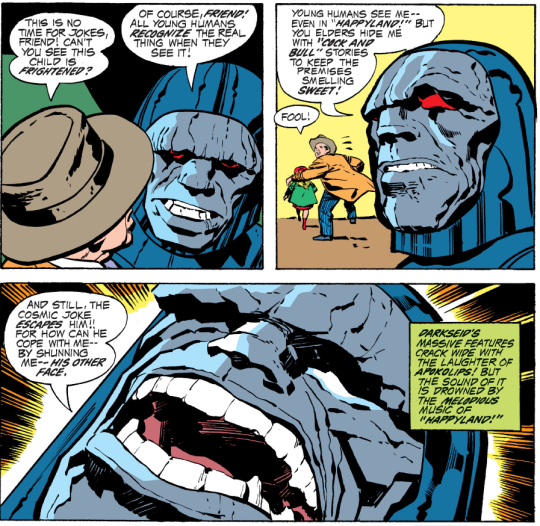
My first experience with Darkseid was in Superman the Animated Series where he was a legitimately intimidating villain both because of the great voicework by Michael Ironside, and because the actions he took and their real impact.

But as a recurring existential threat he falls flat. Because he's pure evil, he's immutable. He's inflexible.
"Darkseid is."

Maybe that’s not fair. I think he can be a good recurring threat, but often isn’t because resolving a conflict with him takes a certain tact. As scary as he is, as powerful as he is, he’s a villain in Superhero comics. If it comes down to a fight he is going to lose. Superman will win that 1 on 1.
Darkseid as an in your face threat can fall flat because that pure good vs pure evil beat down is straightforward. Where Darkseid shines as a villain is in the shadows. The puppet master pulling the string. Because then Darkseid isn’t just a giant evil rock man in space for Superman to punch, he is also Granny Goodness, Desad, Kalibak, Lex Luthor, and every two bit crook along the way. He is every pain along the way, every compromise, every dark thought, every mistake, every failure.
“Darkseid is.”

But Darkseid is also a literal evil rock man in a skirt. And a joke. So the other way Darkseid really works is when he shows up on your couch.
“Darkseid is.”
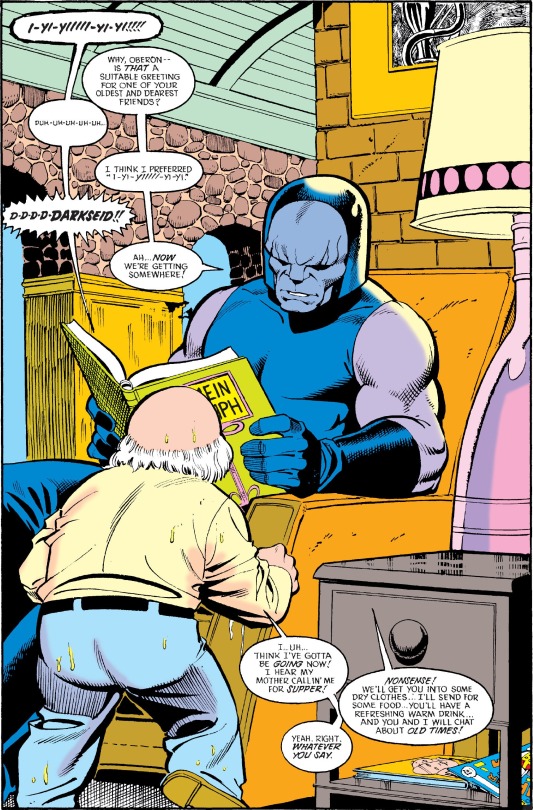
Sometimes it’s just a comfy chair or handing you your McDonalds order but the point is he’s just there in the mundane part of the character’s life. His evil permeates everything and because he’s a literal evil rock monster from space sometimes that means an evil eight foot rock monster in a skirt is sitting in your house waiting for you when you get home. “Couchseid” he is sometimes called.
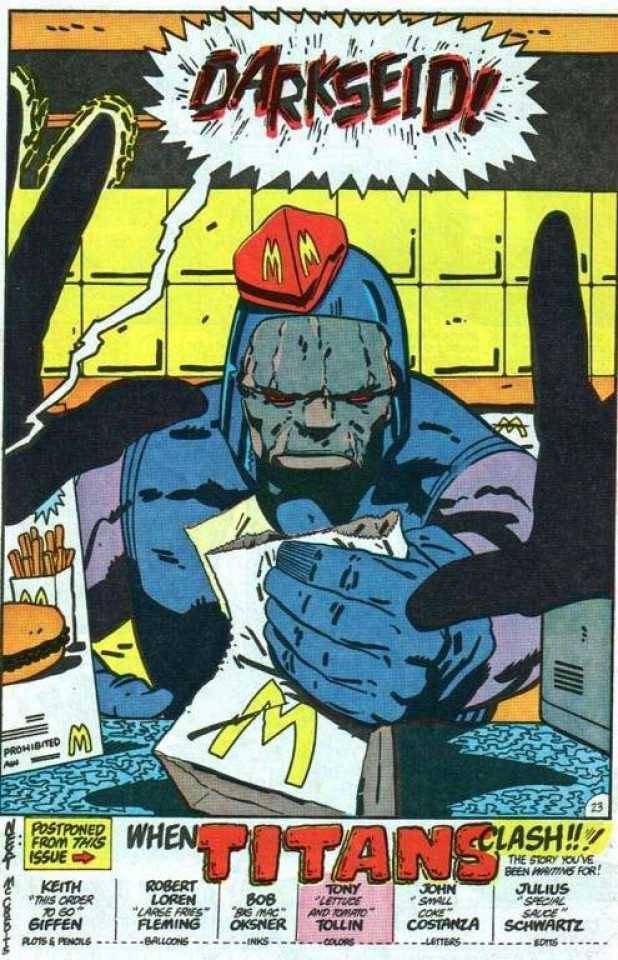
The reason I went through all that is that’s the thoughts and feelings I had about Darkseid going into this comic. The baggage of expectation and desire I had going in. And before I get into the details I just want to say that this comic completely nails this idea. In fact the entire comic embodies it, extending it out to the entire Fourth World. Contrasting the high fantasy war of good and evil Gods with the mundanity of normal life at every level.
Ok, now let’s dig into Mister Miracle.

Mister Miracle written by Tom King with art by Mitch Gerads and lettering by Clayton Cowles opens with Mister Miracle bleeding out in his bathroom having slit his wrists in a suicide attempt. That’s where we start.
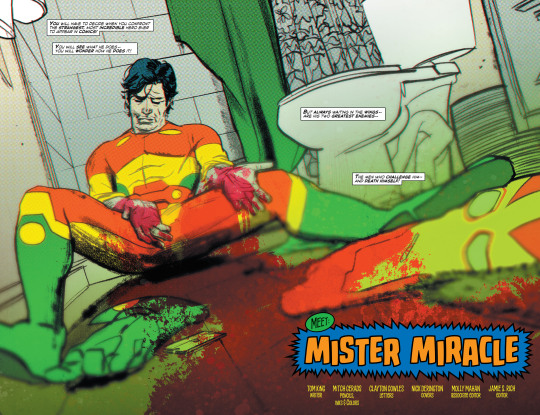
“Darkseid is.”
Jack Kirby’s New Gods #1 opens with an epilogue. “There came a time when the old Gods Died!” That’s where we start.

Mister Miracle is a book about dealing with trauma and the trauma at the heart of The New Gods is the exchange; where Darkseid and Highfather exchanged sons to end a vicious war and bring peace to their worlds. This is the first comic I’ve seen question if that exchange was worth it. What does it say about Highfather that he was willing to sacrifice his infant son and condemn him to hell, even though that meant saving countless lives?
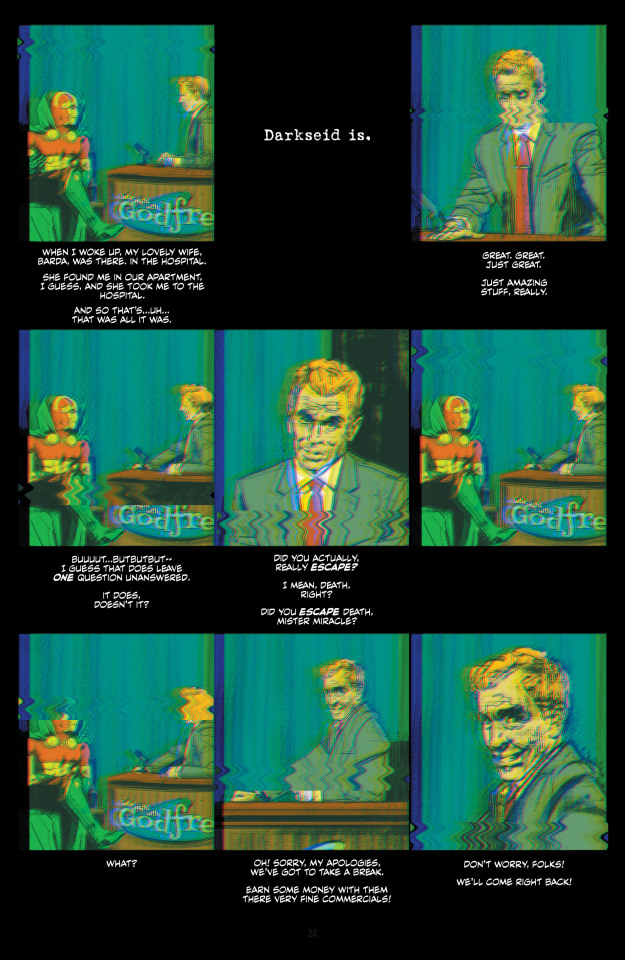
This comic can do that because this version of Mister Miracle, Scott Free, is so clearly suffering from abuse and trauma and PTSD and this version of Orion is such a jerk and unheroic.

For Scott and Big Barda the Earth is their home, they have an apartment there, they have normal domestic concerts. Being New Gods and fighting in that war is their day job. But for Orion that war is his life. He is single minded in his desire to destroy Darkseid and his own moral authority. He sees only in absolutes. He’s a cartoon, and in the real world that makes him a monster.
“Darkseid is.”
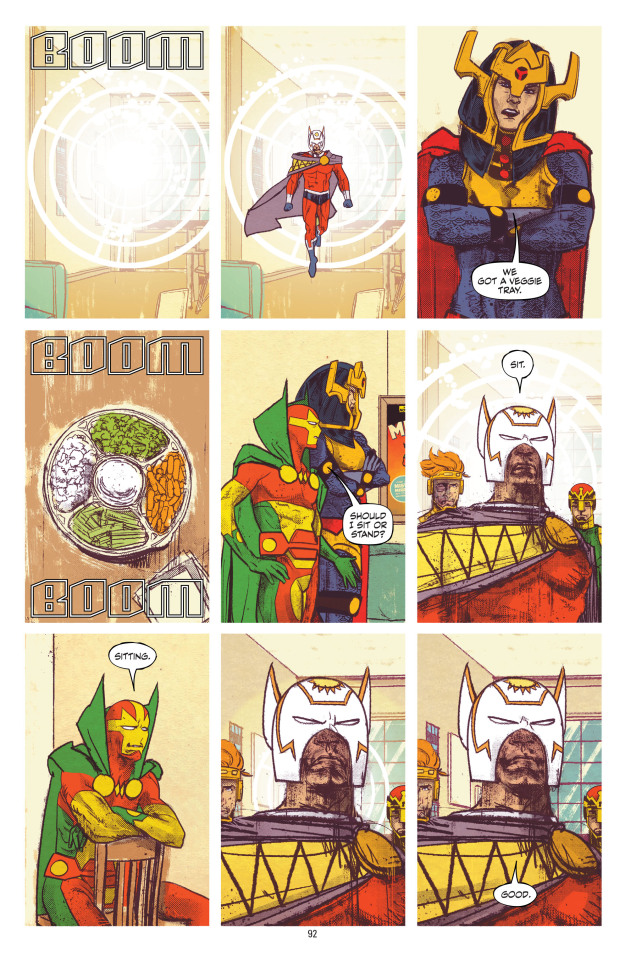
So there’s another aspect of Mister Miracle that I haven’t talked about that I love and that all starts with Funky Flashman.
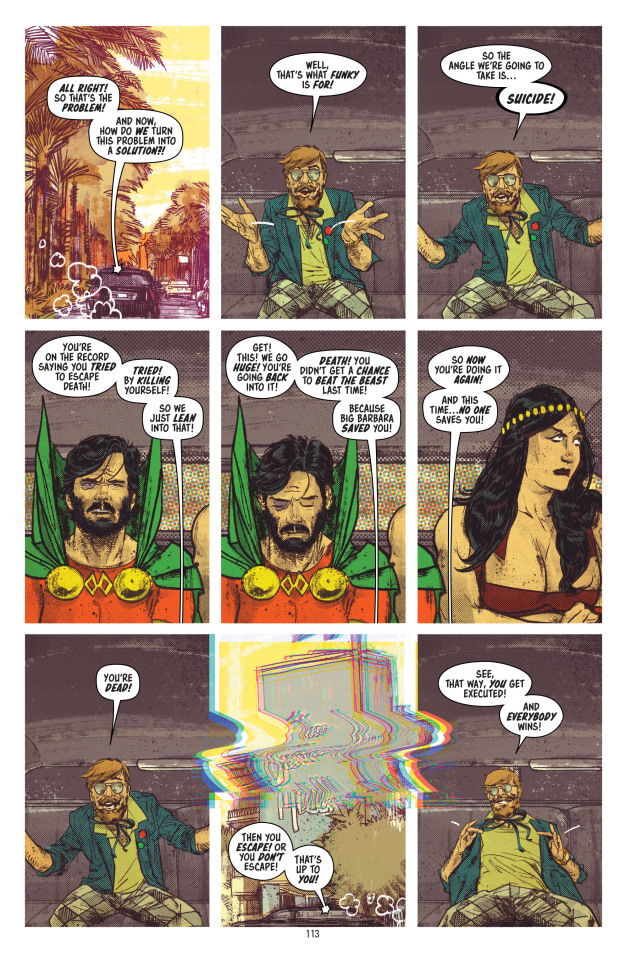
Funky Flashman is Jack Kirby’s parody of Stan Lee. Well, of the public persona of Stan Lee. He’s out here shouting “ Excelsior!” and whatnot. Tom King and Mitch Gerads make the most of getting to have Stan Lee in their comic. The whole other layer to Mister Miracle beyond its plot is that it’s also a tremendous tribute to Kirby himself, including his work at Marvel. It’s extra crazy that that made it into this DC comic.
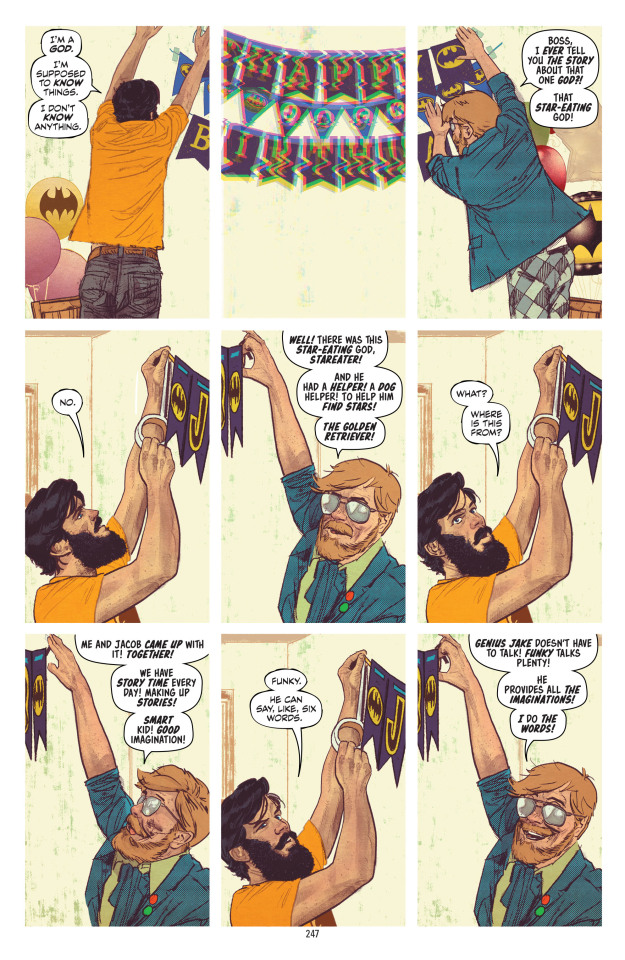
There’s Scott Free’s trial, which takes place in his apartment, that can be read as Kirby up against Steve Ditko’s objectivist beliefs. But the most blatant and amazing is a retelling of The Coming of Galactus and its place within this story. This is legitimately one of my favorite things in any comic I’ve ever read.
It just makes me so happy.

Mister Miracle is a comic I can’t get out of my head. It has so many perfect moments, whether they’re heartbreaking and tragic or uplifting and life affirming; emotional or frivolous, serious or hilarious. It knocks it out of the park on every front. It’s an unbelievable piece of craft.

Back to Darkseid.
In Kirby’s Fourth World Good is always stronger than Evil. That’s foundational. Superman is going to win. Darkseid eventually loses no matter how scary or intimidating he is. But...
“Darkseid is.”

He’s also pernicious and enduring. Ultimately, punches alone aren’t going to solve him. There is some catharsis in that. That’s how Superman: The Animated Series ended; with Superman pummeling Darkseid into submission. But it’s not quite what you want, or at least it’s not quite enough. What’s the answer to “Darkseid is?” What’s the counterpoint? “Darkseid is” is the setup, but you need a punchline.
At the end of Mister Miracle we get exactly that. It’s simple and perfect.

Mister Miracle written by Tom King with art by Mitch Gerads and lettering by Clayton Cowles is a masterpiece and I cannot recommend it highly enough.
So it goes.
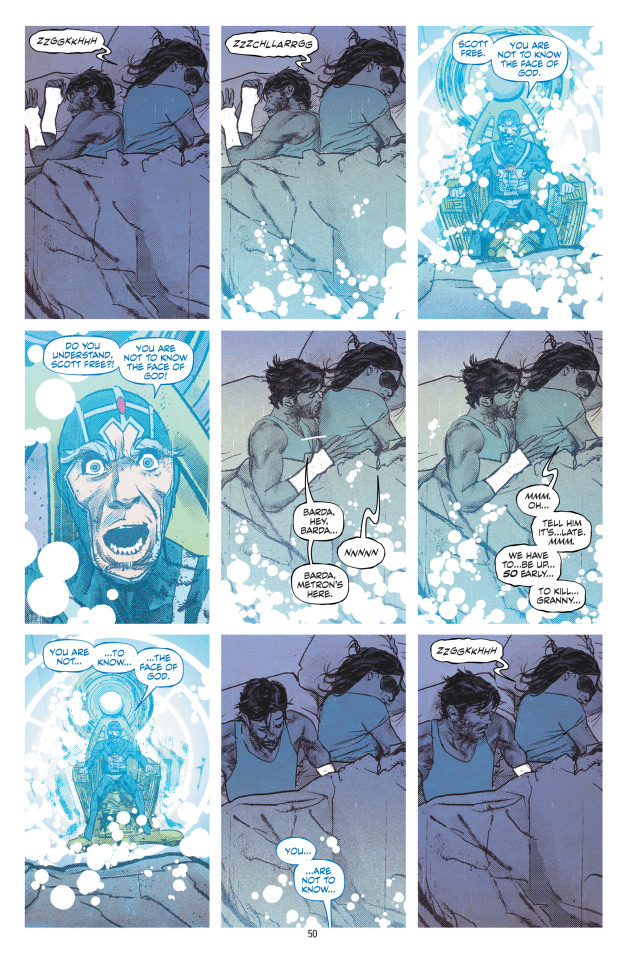
Thank You For Your Time.
#mister miracle#the new gods#comics#dc comics#tom king#mitch gerads#review#comic review#comic books#clayton cowles#jack kirby#stan lee#Big Barda#Funky Flashman
175 notes
·
View notes
Text
Ngl, while I am hyped for whatever Ava Duvernay is doing with New Gods, I think Taika Waititi would have been an amazing fit for New Gods after reading the the meta-text behind Thor: Ragnarok. I mean using Kirby stories to spread an anti-facist message? That is basically New Gods hat. I say have both, because I can’t get enough of well written New Gods.
I say have Waittiti on Forever People, the diverse group of kids who fight the religious right, while Duvernay does the Mister Miracle/Big Barda movie. Maybe get someone else to do the Orion movie.
#Taika Waititi#Ava Duvernay#new gods#forever people#mister miracle#big barda#dc#Does tumblr have a New Gods fandom?
26 notes
·
View notes
Text
Jimmy Olsen, Superman's Pal, Brings Back the Newsboy Legion!

SUPERMAN’S PAL, JIMMY OLSEN #133
OCTOBER 1970
BY JACK KIRBY, AL PLASTINO AND VINCE COLLETTA
SYNOPSIS (FROM DC WIKIA)
Jimmy Olsen is paired with the new Newsboy Legion, the sons of the original boy heroes plus Flippa-Dippa, a newcomer, to investigate the Wild Area, a strange community outside of Metropolis.
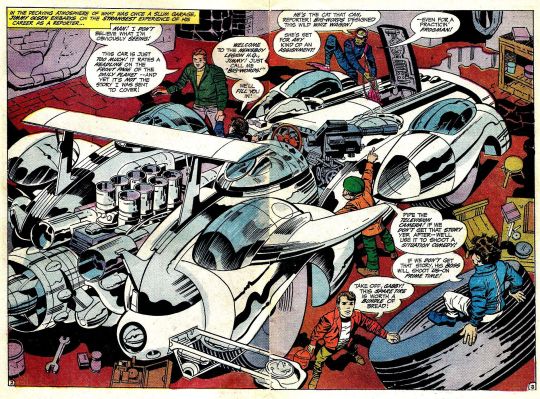
The boys are given a super-vehicle called the Whiz Wagon for transport. When Clark Kent shows concern for Jimmy, Morgan Edge, owner of Galaxy Broadcasting and the new owner of the Daily Planet, secretly orders a criminal organization called Inter-Gang to kill him. But Kent survives the attempt, and later hooks up with Jimmy and the Newsboy Legion in the Wild Area.


The youths have met the Outsiders, a tribe of young people who live in a super-scientific commune called Habitat, and have won leadership of the Outsiders' gang of motorcyclists. Jimmy and company go off in search of a mysterious goal called the Mountain of Judgment, and warn Superman not to stop them.
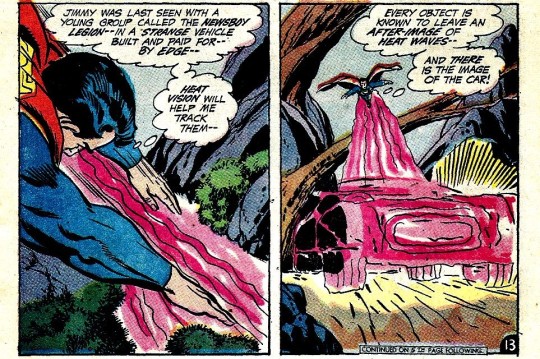



THE BRONZE AGE OF COMICS
The Bronze Age retained many of the conventions of the Silver Age, with traditional superhero titles remaining the mainstay of the industry. However, a return of darker plot elements and story lines more related to relevant social issues, such as racism, drug use, alcoholism, urban poverty, and environmental pollution, began to flourish during the period, prefiguring the later Modern Age of Comic Books.


There is no one single event that can be said to herald the beginning of the Bronze Age. Instead, a number of events at the beginning of the 1970s, taken together, can be seen as a shift away from the tone of comics in the previous decade.
One such event was the April 1970 issue of Green Lantern, which added Green Arrow as a title character. The series, written by Denny O'Neil and penciled by Neal Adams, focused on "relevance" as Green Lantern was exposed to poverty and experienced self-doubt.
Later in 1970, Jack Kirby left Marvel Comics, ending arguably the most important creative partnership of the Silver Age (with Stan Lee). Kirby then turned to DC, where he created The Fourth World series of titles starting with Superman's Pal Jimmy Olsen #133 in October 1970. Also in 1970 Mort Weisinger, the long term editor of the various Superman titles, retired to be replaced by Julius Schwartz. Schwartz set about toning down some of the more fanciful aspects of the Weisinger era, removing most Kryptonite from continuity and scaling back Superman's nigh-infinite—by then—powers, which was done by veteran Superman artist Curt Swan together with groundbreaking author Denny O'Neil.
The beginning of the Bronze Age coincided with the end of the careers of many of the veteran writers and artists of the time, or their promotion to management positions and retirement from regular writing or drawing, and their replacement with a younger generation of editors and creators, many of whom knew each other from their experiences in comic book fan conventions and publications. At the same time, publishers began the era by scaling back on their super-hero publications, canceling many of the weaker-selling titles, and experimenting with other genres such as horror and sword-and-sorcery.
The era also encompassed major changes in the distribution of and audience for comic books. Over time, the medium shifted from cheap mass market products sold at newsstands to a more expensive product sold at specialty comic book shops and aimed at a smaller, core audience of fans. The shift in distribution allowed many small-print publishers to enter the market, changing the medium from one dominated by a few large publishers to a more diverse and eclectic range of books.
JACK KIRBY
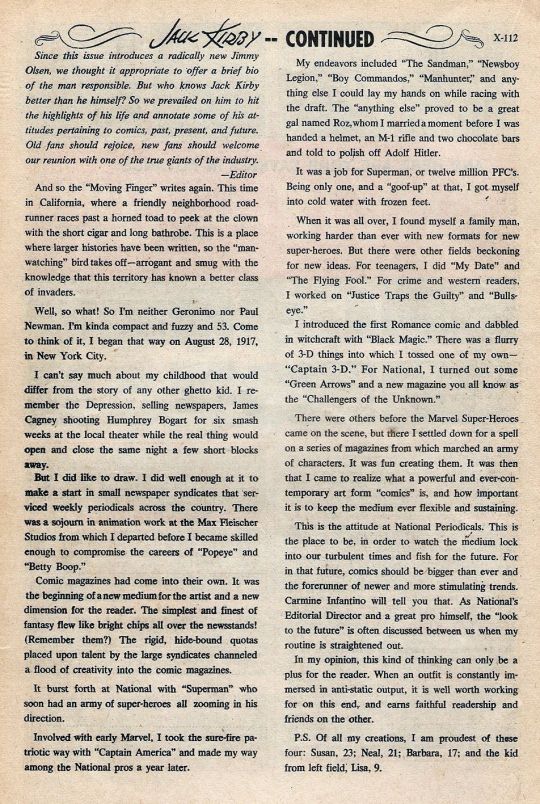
In 1968 and 1969, Joe Simon was involved in litigation with Marvel Comics over the ownership of Captain America, initiated by Marvel after Simon registered the copyright renewal for Captain America in his own name. According to Simon, Kirby agreed to support the company in the litigation and, as part of a deal Kirby made with publisher Martin Goodman, signed over to Marvel any rights he might have had to the character.
At this same time, Kirby grew increasingly dissatisfied with working at Marvel, for reasons Kirby biographer Mark Evanier has suggested include resentment over Lee's media prominence, a lack of full creative control, anger over breaches of perceived promises by publisher Martin Goodman, and frustration over Marvel's failure to credit him specifically for his story plotting and for his character creations and co-creations. He began to both write and draw some secondary features for Marvel, such as "The Inhumans" in Amazing Adventures volume two, as well as horror stories for the anthology title Chamber of Darkness, and received full credit for doing so; but in 1970, Kirby was presented with a contract that included such unfavorable terms as a prohibition against legal retaliation. When Kirby objected, the management refused to negotiate any contract changes. Kirby, although he was earning $35,000 a year freelancing for the company, subsequently left Marvel in 1970 for rival DC Comics, under editorial director Carmine Infantino.
Kirby spent nearly two years negotiating a deal to move to DC Comics, where in late 1970 he signed a three-year contract with an option for two additional years. He produced a series of interlinked titles under the blanket sobriquet "The Fourth World", which included a trilogy of new titles — New Gods, Mister Miracle, and The Forever People — as well as the extant Superman's Pal Jimmy Olsen. Kirby picked the latter book because the series was without a stable creative team and he did not want to cost anyone a job. The three books Kirby originated dealt with aspects of mythology he'd previously touched upon in Thor.
The New Gods would establish this new mythos, while in The Forever People Kirby would attempt to mythologize the lives of the young people he observed around him. The third book, Mister Miracle was more of a personal myth. The title character was an escape artist, which Mark Evanier suggests Kirby channeled his feelings of constraint into. Mister Miracle's wife was based in character on Kirby's wife Roz, and he even caricatured Stan Lee within the pages of the book as Funky Flashman. The central villain of the Fourth World series, Darkseid, and some of the Fourth World concepts, appeared in Jimmy Olsen before the launch of the other Fourth World books, giving the new titles greater exposure to potential buyers. The Superman figures and Jimmy Olsen faces drawn by Kirby were redrawn by Al Plastino, and later by Murphy Anderson.
Kirby later produced other DC series such as OMAC, Kamandi, The Demon, and Kobra, and worked on such extant features as "The Losers" in Our Fighting Forces. Together with former partner Joe Simon for one last time, he worked on a new incarnation of the Sandman. Kirby produced three issues of the 1st Issue Special anthology series and created Atlas The Great, a new Manhunter, and the Dingbats of Danger Street.
Kirby's production assistant of the time, Mark Evanier, recounted that DC's policies of the era were not in sync with Kirby's creative impulses, and that he was often forced to work on characters and projects he did not like. Meanwhile, some artists at DC did not want Kirby there, as he threatened their positions in the company; they also had bad blood from previous competition with Marvel and legal problems with him. Since he was working from California, they were able to undermine his work through redesigns in the New York office.
REVIEW
If you are a ninenties creature like me, you remember all these concepts very well, because they came back in the form of Cadmus in the superman titles of the “triangle” era. This is proof that Kirby left a big legacy on more than one company. It is sometimes hard to tell where Kirby starts and where other writers come in. It is hard to tell on his Marvel work at least (and Stan Lee would often take credit for Kirby’s work). So the Fourth World is a good place to check on the real Jack Kirby. Away from Joe Simon, away from Stan Lee.
Now, about this issue. As I said, I knew most of these things from the 90′s Superman titles (that was also the last time Jimmy Olsen mattered). But I have to imagine what it was like to new readers... Jimmy Olsen readers in particular, that a few months ago were reading about Superman trying to prevent Jimmy (an adult) from being adopted. I also have to have in mind that comic-book readers were probably very aware of who Jack Kirby was. The sixties were pretty much dominated by Marvel, and a big part of that success was because of Kirby. But, as I said before, Stan Lee would take the media and take credit for everything. So I am not sure how aware casual readers were with Jack Kirby.
If they weren’t, by this issue they probably were, as DC did a lot of fanfare about the fact that Kirby was coming to DC. Some people compared Bendis coming to DC to this period of time in particular. While there are similarities, it is too early too judge Bendis legacy at this point in time.
The story in this issue is ok. There are a lot of characters and plots being introduced. It’s the first appearance of Morgan Edge, the Wild Area, the Outsiders, the Newsboy Legion (Junior) and other concepts. It is important to remark that this Newsboy Legion is not the golden age version of that group. They are the sons of the originals (and they look pretty much the same... and dress the same). Flip is a bit weird, though. I am pretty sure he doesn’t need the scuba kit on all the time. I will be reviewing the original Newsboy Legion in the golden age reviews.
The art is better than the usual Kirby style, but as it was said above, Al Plastino redrew Superman and Jimmy’s faces. This was common practice at DC, as they didn’t want their most emblematic characters changing too much from issue to issue.
I give this issue a score of 8
#jack kirby#al plastino#fourth world#vince colletta#gaspar saladino#bronze age#dc comics#1970#jimmy olsen#superman's pal jimmy olsen#newsboy legion#comics#review
4 notes
·
View notes
Text
A Christmas List for the Fan in All of Us

An Occasional Attempt to Read, Discuss and Review the Wonders of Comics
By: John Rafferty, cranky old man, and Fan of All Things Comics
A Christmas List for the Fan in All of Us
Greetings Gentle Readers! As the Holidays approach, whether Christmas, Chanukkah, Kwanzaa, Yule, Saturnalia, Krampusnacht, or whatever you might celebrate, our thoughts invariably turn to trying to find the PERFECT GIFT for that Special Someone, let me offer some suggestions:
MARVEL
For the Avengers Fan:
The Kree - Skrull War - Recently re-collected, this is the basis for Captain Marvel, as well as 70% of the Marvel Comics Mythology, as all the heroes, from the Silver Age, through to the Present have had conflicts with either the Kree, the Skrull, or both.
Roy Thomas, Neil Adams, Sal and John Buscema bring these stories to life, crossing years, and parsecs to bring these characters to you.
For the Spider-Man Fan:
Kraven’s Last Hunt - Kraven the Hunter has hunted, captured, and killed every dangerous creature he has sought out… Except one. In his final quest, Peter Parker’s alter ego will be his quarry, and Kraven will prove he is the better by capturing, killing, and BECOMING SPIDER-MAN!
One of the greatest of the Spider-Man stories, this is best acquired in the Deluxe Edition, which carries the sequel story.
This JM DeMatteis and Mike Zeck’s masterpiece, and a story that is always discussed as one of the Five Best Spider-Man Stories.
For the X-Men Fan:
God Loves, Man Kills - An X-Men story written as a Graphic Novel, due to the graphic nature, and subject matter, this book really looks at the concepts of racism and religious bigotry, through the glass of the ‘Mutant Menace’. Written in 1982, the lessons carry through today, maybe mores than they did then.
I am sure when Brent Anderson and Chris Claremont brought this to life, they had no idea of the relevance it would carry 40 years after.
For the Black Panther Fan:
Panther’s Quest and Panther’s Rage - Two collections, written by Don McGregor, drawn by Rich Buckler and Gene Colan, which became the basis for the Black Panther we see today. Prince T’Challa, defending Wakanda from the onslaught of social injustice and invading mercenary armies, while in search of his mother, who until now was thought to be dead.
This is the character portrayed by Chadwick Boseman, regal, intelligent, strong, and fair.
For the Daredevil Fan:
Daredevil by Frank Miller and Klaus Janson 1&2 - I know, this is a big one, but if they never read this before, they will love you forever. And if they have, they will love you anyway, because the Miller books are priceless, and not to be read regularly.
This is the seminal Daredevil Story, from which all Daredevil stories grew. Everything before it was nice. Everything after, a pale shadow. This is brilliance.
DC
For the Superman Fan:
Whatever Happened to the Man Of Tomorrow - Written by Alan Moore, drawn by Kurt Schaffenburg and Curt Swan, this reprints the two part story which asks the question: Where did Superman Go?
Many of these collections also include the Alan Moore story ‘For the Man Who Has Everything’, which is a real added bonus, as it is also a great story.
For the Batman Fan:
The Dark Knight Returns - This is the inspiration for the dark, gritty Batman we know now from the Christopher Nolan BATMAN films., as well as the Snyder Batman in BvS, and Justice League.
The fight scene between Batman and Superman its directly from the third issue of this story. It is a MUST READ for any Comics Fan.
For the DC Fan:
Mister Miracle - The collected Jack Kirby, or the collected Tom King maxi-series, it doesn’t matter which one. Both are phenomenal.
The Kirby Collection is from the late 60’s, and the King - Gerads collection is from 2017.
Kingdom Come - Mark Waid and Alex Ross create a future where the old guard of heroes have removed themselves from the public eye, and the new breed which have taken their place have little or no regard for those they are supposed to be protecting, creating a terrified populous looking to lash out rather than reason.
This book is beautifully rendered by the man who is currently considered the greatest superhero artist of the day, as Alex Ross’ paintings can be as covers, and if lucky, interiors of some current comics.
Watchmen - The book which inspired the movie, and the recent HBO series, this is Alan Moore and Dave Gibbon’s tribute to the Charlton characters of old, and a story about what happens when there are no checks and balances on the powerful.
Another object lesson for today…
For the Comics Fan:
Spawn - Todd McFarlane’s creation, Al Simmons, after a long distinguished service to his country becomes an assassin for the CIA, and is summarily murdered by his friend. As a reward for his career as an assassin, he is sent to Hell, where he makes a deal with a devil, agreeing to become a Helspawn, and serve Malebolgia, in exchange for seeing his wife Wanda one last time.
Al learns twi things. First, never trust a devil and second, you CAN break a deal with Hell, if you don’t violate the letter of the deal.
This series is collected in many volumes, I’d try to find Origins Vol 1…
Saga - Written by Brian K Vaughn, drawn by Kieron Gillen, this is the story of Hazel, a child born to parents from opposite sides of a never ending galactic war. Hazel’s family risks life and limb to try to find a peaceful future for themselves, in a universe that would see them dead, rather than let them exist.
While available in many editions, the Compendiums which collect 15 - 18 issues are the best way to read this.
Other Things:
Funko Figures - Whether Superheroes, Television Characters, Movie Characters or Pop references (There’s a Grumpy Cat… WHY!!??!!), there’s something for everyone in the Funko Line of figures
Q-Fig - Newer to the scene, these are more detailed, and smaller than Funko figures. They are also more expensive.
But, in their defense, they are MUCH COOLER!
Let’s face it, if you visit your Friendly Neighborhood Comic Purveyor, he will definitely be able to point you in the direction of something amazing for the special Fan in your life!
Happy Shopping!
1 note
·
View note
Photo

#JackedKirby - My Immortal Enemy!!! The Denon is a tour de force for Jack in his career... but what makes it so confounding is that the series was merely created to fulfill contractual obligations to DC Comics. Despite that being why the series was created, the 16 issues that exist are packed with some of the greatest quality art and stories of Jack's career. Jason Blood aka Etrigan the Demon has been in a struggle over time with the evil witch Morgaine Le Fey. This dates back to the era of King Arthur and the Knights of the Round Table. But in the series Morgaine is back in modern times and Etrigan is trying to stop her at all costs. Unfortunately in #Issue16 (which was published in January of 1974) he is captured and rendered helpless from a spell by the sorceress. Never one to take her capture of an enemy for granted, she also imprisons Etrigan in a weird harness like metallic trap. This is Kirby being Kirby, as the trap is very bizarrely constructed and puts Etrigan in quite an awkward physical alignment. The trap also looks EXACTLY like something that would have be used to imprison Mister Miracle!!! Le Fey is the villain, so of course she can not win... so eventually The Demon escapes his temporary imprisonment to defeat her. Although the story ends on a decent ending note... it's definitely not a series finale that we deserve. Not for something as well written as drawn as The Demon was over 16 issues. #JackKirby #KingKirby #Kirby #TheDemon #Etrigan #JasonBlood #MorgaineLeFey #KingArthur #KnightsOfTheRoundTable #DCComics #70sComics #ComicsOfThe70s #Comics #ComicBook #Comic #ComicBooks #KirbySplashPages #SplashPages #KirbyTech #KirbyTraps #IGComicCommunity #IGcomics #ComicsOfIG
#kirbysplashpages#issue16#kirbytraps#jackedkirby#etrigan#thedemon#dccomics#kingkirby#morgainelefey#kirby#knightsoftheroundtable#kirbytech#kingarthur#comicsofthe70s#comicsofig#comicbook#jasonblood#jackkirby#igcomics#igcomiccommunity#comicbooks#comics#splashpages#70scomics#comic
2 notes
·
View notes
Photo
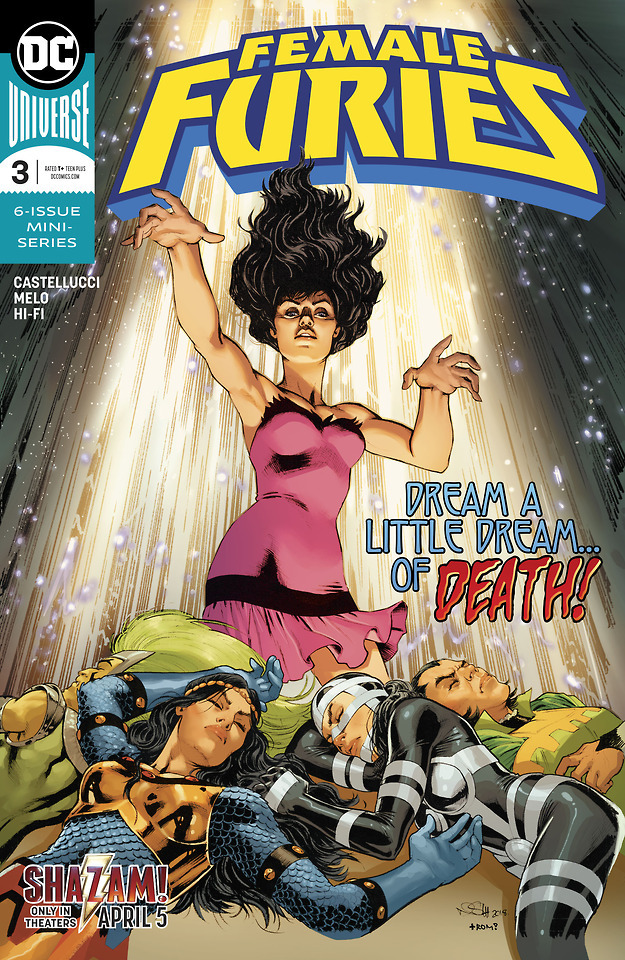
Female Furies #3 Review
Written by: Cecil Castellucci
Illustrated by: Adriana Melo
Colors by: Hi-Fi
So. Allow me to preface everything I am about to say by stating I have absolutely no issue with the story concept. A comic addressing feminist concepts or a story addressing the likely less than pure interactions the Furies may have had with others in Darkseid’s employ. Both are good concepts that can work with the right writer. And while the comic here tries for the former and manages to make a decent story of abuse and efforts to escape it, it does so after distorting the society of Apokolips as it has been represented since approximately 1971. I will go off on the other major change that weakens the story at the end, because I do want to cover the content.
The comic opens with Beautiful Dreamer being tortured by Granny Goodness, who eventually manages to get Dreamer’s powers working to try and ‘right’ the Furies after their current disarray that Aurelie has caused. And it works on the majority, successfully managing to indoctrinate all of the Furies. Well, except for Aurelie, whose abuse at the hands of Willik is corrupting Dreamer’s efforts to give Aurelie a beautiful dream. So instead, Dreamer seizes on the chance, inviting Aurelie into her memories to show her how the Forever People live. And eventually, Aurelie is sold on the idea as she sees she would be able to freely dance. Dreamer allows Aurelie to awaken while the other Furies are kept asleep, with the promise for them both to escape. And as she enters the room, Granny Goodness is still awake enough to attempt to detain Aurelie.
And the conversation the pair have, its definitely a very pointed one about how abuse need not continue simply because you endured it and so should those who come after you. Its honestly the best moment of the comic. I really like it. And when granny begins to lose ground on her argument, she tries to choke out Aurelie. At which point Dreamer gets up, giving Granny Goodness an illusion of how things ended for the happy memory Granny used to make Dreamer’s powers work. And so the pair slip away to Himon, the leader of the Apkolips Resistance.
Before pursuit can continue however, Granny Goodness is summoned to Darkseid’s....side. He wishes to discuss how exactly Dreamer got on Apokolips and how her powers may be used to determine the Anti-Life Equation due to their ability to destroy will. When Darkseid mentions how Scott Free may be the one who betrayed him, Granny Goodness leaps onto the idea so as to keep her being the one to bring Dreamer to Apokolips secret. So, with this knowledge, Granny gets the Furies ready to try and recapture Aurelie for reconditioning and to prepare to annihilate Himon’s operation.
So they burst in and quickly detain Aurelie, hauling her back to Willik straight away. However, when Barda is about to capture Himon, Scott Free speaks up and announces that Himon is under his protection. After getting Barda’s name, Scott and Himon escape the lair and leave Barda there stunned.
Back on Apokolips, Granny tortures Aurelie for being too weak to handle what Willik is doing to her before sending her off with Willik. And Willik, after having her escape, decides to show how he feels about that by encasing her legs in red-hot boots and forcing her to dance until her legs literally MELT AWAY! Which is about the most Apokoliptian way I can think of to torture a dancer to death. Barda finds her moments before she passes on, where Aurelie mentions the possibility of a world beyond Apokolips before passing on.
The comic ends with Barda and the other Furies at Aurelie’s funeral, with Barda attempting to persuade her fellow Furies as to the truth of Aurelie’s death and not the training accident excuse that Willik gave.And as the other Furies leave, Barda hears a voice behind her. Its Scott Free, wanting to offer help in escaping away from Apokolips.
Before I mention the other sticking point for me, I’ll talk about the art. Because I really like the art here. While the backgrounds will be a simple color gradient most of the time, the character models all look very evocative, the expression work really helps sell the emotions that each character is experiencing, and the motion that the art is able to convey can be as massive as Granny Goodness backhanding a knife out of Aurelie’s hand to smaller gestures such as Granny’s motioning with her hands during her discussion/meal with Darkseid.
But now....Its time to talk about Scott Free and Barda. Or as they are better known, Mister Miracle and Big Barda. Scott has honestly gotten the worst end of the adjusting to Apokolips’ society. Originally, he was Darkseid’s adopted son that he had placed under Granny Goodness to punish him until he broke and became subservient to Darkseid. Scott....did not do that. So Granny Goodness would think up more elaborate traps and tortures that he would inevitably escape. As a result, he learned of Himon as a resistance leader and began to learn under him during his time between torture sessions.Meanwhile, Barda had met Scott during one of the Fury raids and began to fall in love with him due to the peace he exuded in contrast to tumult, torment, and despair that Apokolips had attuned her to. And they meet together with Himon, to try and overthrow Apokolips or just simply escape.
Meanwhile, this comic has mostly shown Scott Free as a generic soldier of Apokolips that Barda has no idea why she appears to be attracted to him. It just feels so much weaker than the story that was originally told with them. But it doesn’t take away from the story its trying to tell. Neither do the changes to Apokolips. But it just feels like the story that had already been created with the Fourth World and Apokolips, the story that Jack Kirby started, is being overwritten. So, if you have less attachment to the New Gods, Im sure you will be a lot more likely to enjoy this comic. But the messages in the comic, those I fully stand behind. Legitimately, the story does have these great moments where it shows the abuses and neglects that men and other women can inflict over this stuff. And just because I don’t fully enjoy the wrapping that it came in doesn’t mean I can’t like the message it contains.
#darkseid#apokolips#female furies#dc#dc comics#comic#comics#comic book#comic books#comic book review#review#taffys take
0 notes